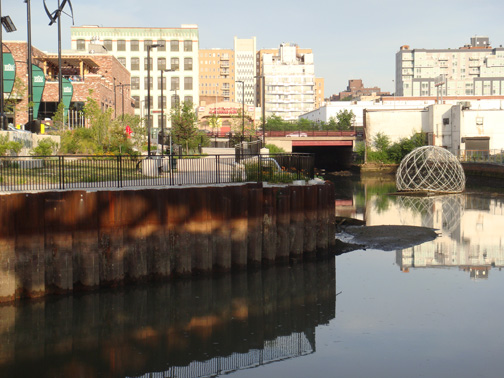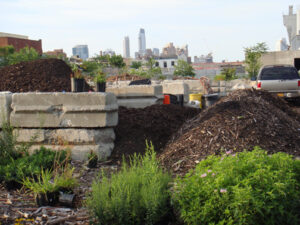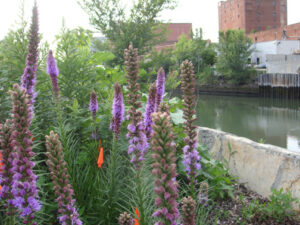Gowanus means many things to the community. For most it is a neighborhood, to others a polluted canal, but to the Gowanus Canal Conservancy (GCC), it represents more. To the GCC, Gowanus is a watershed. A watershed, also known as a drainage basin is an area where water from rain and melting snow or ice converge to a single point at a lower elevation then join another body of water, such as a river, bay or ocean.

The neighborhoods that are within the watershed include not just Gowanus, but Carroll Gardens, Cobble Hill, Park Slope and Red Hook.
The GCC is a community-based non-profit organization that serves as an environmental steward for the area with the mission of creating green spaces and parks along the shores, cleaning up the canal and improving the water, soil and air quality within the watershed area.
The Gowanus neighborhood has undergone controversial changes recently, most notable being large-scale building and proposed re-zoning laws which govern development. There are a myriad of groups, organizations and agencies advocating for various causes. According to GCC board member Ben Jones, “Gowanus is a dynamic neighborhood and there are lots of groups that are a part of the dialogue, including the Gowanus Preservation Society”. Mr. Jones also mentions the “Conservancy’s role is to help build consensus around key initiatives and priorities that will make the canal and its environs clean, vibrant and resilient”.
The three biggest forces the GCC battle are pollutants from nearby industrial sites and combined sewer overflow and surface run-off from heavy rains. Initiatives and projects the conservancy organize on a regular basis combat such forces. One such example is the planting of trees and native flora to retain storm water run-off.
Working with an amazing pool of talent, Executive Director Hans Hesselein has taken the conservancy to the next level. Hesselein started his tenure with the conservancy as a volunteer, then quickly rose through the ranks from Director of Special Projects to become the Executive Director. Recently, on July 16th on the banks of the canal at popular watering hole, Lavender Lake, Hesselein received an honor from Councilmember Brad Lander, recognizing his efforts as well as those of the conservancy.
How it all gets done
While the GCC has a list of corporate and local sponsors and receives help from elected officials such as Councilman Lander, the brunt of the work is accomplished by staff, board members, volunteers and interns.
Volunteer and member events hosted at the “Salt Lot” on 2nd Ave provide a hub for cutting edge and traditional ecological improvement tactics. It’s not just how and what the conservancy does that’s impressive, but the massive scale. The Composting Gowanus project is an example.

Composting Gowanus
Some of the conservancy’s most frequent and best known activities include the monthly compost windrow build and various clean & green events.
Windrow composting is common on large farms and based on organizing materials in long rows. As this method is suited to producing large volumes of compost, it’s much different than bin composting in local community gardens. On a regular basis, volunteers and staff turn the windrow to improve breathability and oxygen content, mix in or remove moisture, and redistribute cooler and hotter portions of the pile. Other factors given attention include the ratio of carbon and nitrogen rich materials. The temperature of the windrows must be measured and logged regularly to determine the optimum time to turn them for quicker compost production.
Composting Gowanus has been an on-going project of great scale. While a community garden may compost food scraps for a 2-3 block radius into a bin, the GCC collects monthly, on average of 5 tons of “green” nitrogen based food scraps. These are combined with “brown” carbon based compostable items such as leaves, twigs, bark, etc. until the ideal carbon to nitrogen ratio is reached.
The finished product is used in re-invigorating areas along the canal to form a nutrient rich soil. Trees, shrubs and re-introduced native vegetation planted in the soil plays a role in absorbing surface run-off, acting as a barrier preventing pollution from entering the waterway. Additional compost is also distributed in other areas including community gardens.
Clean & Greens and Tree Mapping
In addition to composting, monthly Clean & Greens are a great opportunity for first time and experienced volunteers to make a difference in the community and meet their neighbors. Anyone can join in to help with weeding, building vertical planters and even watch canoes paddle into the canal to strategically place floating gardens. Each summer the GCC also partners with the Gowanus Alliance helping to keep Ennis Playground looking great, providing a safe haven for residents to enjoy and a place for children to play. At the conclusion of some work days there is a gathering and BBQ for all participants to reward everyone’s hard work.
Tree-Mapping, yet another initiative on plate of the GCC consists of logging tree species, sizes and health. Last summer, an inventory over 1,000 trees within a 2-blocks of the canal was recorded.
Other community programs include the Urban Ecology Lecture Series, K-12 Public School Education and Canal Walking Tours. During tours participants visit historical sites, discuss sustainability, conservation projects, and local urban plants and wildlife.

The Next Phase
In 2010 the canal was granted Superfund status meaning the federal government has designated the Gowanus Canal contaminated with hazardous substances as well harmful pollutants or contaminants. The GCC goes one step further recognizing it’s not just the canal that’s the issue but all ecological processes within the watershed. The GCC will continue to work with with the superfund Community Advisory Group (CAG) as well as other key partners.
It was recently announced that after 5 years of service, Executive Director, Hans Hesselein will be stepping down at the end of July to pursue a career in landscape architecture.However, one person or organization cannot hold the responsibility of re-vitalizing a sustainable and healthy watershed on their own. Only when there is true collaboration with elected officials, an open dialogue with groups and agencies such as the DEP, Build It Green NYC, The Superfund CAG, The Gowanus Alliance and the Gowanus Preservation Society, can a consensus and plan-of-action be implemented. Regarding the future of the GCC and the neighborhoods served, board member Ben Jones commented, “We want to make sure there’s not only a holistic plan for cleaning the canal, but also a long term plan for keeping it clean and healthy for generations to come”. Jones also points out that “The future is very bright. We have an amazing and growing group of volunteers who are the engine behind our work, making a visible, direct impact on the health, beauty and resilience of the watershed”.
Upcoming events include the Compost Windrow Build and Clean & Green on Sunday, August 17th, 11am-3pm. Those wishing to volunteer or to become a member should contact info@gowanuscanalconservancy.org or refer to their website for more information.








